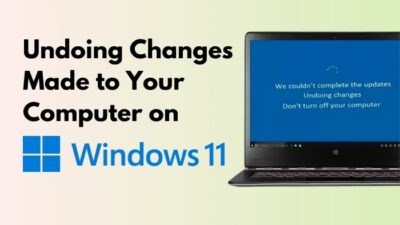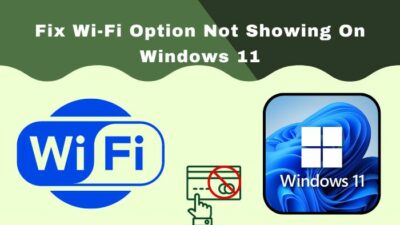Windows 11 is a great Operating System. Although it has newer features, a more sleek and modern design and claims to have better gaming performance, it has some issues yet to be fixed.
On top of that, Windows 11 has newer requirements like TPM 2.0 and Secure boot needs to be enabled for many games and apps to run. Many users do not like these properties of Windows 11 and after facing them, they want to revert back to using Windows 10.
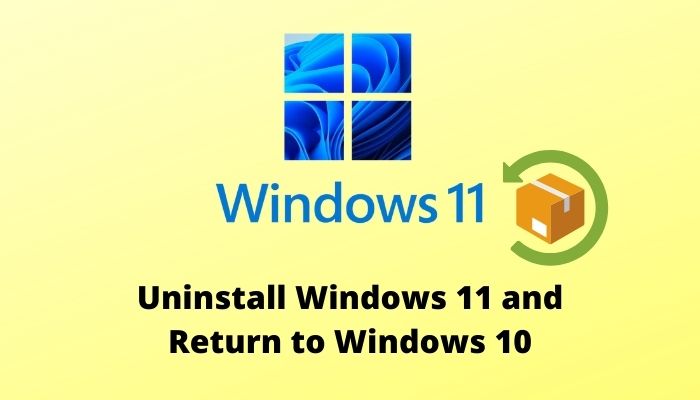
Why uninstall Windows 11 and return to Windows 10?
If you are one of the many users who want to uninstall Windows 11 and go back to Windows 10, look no further as I have conducted thorough research and have written the best methods that you can follow to uninstall Windows 11 and go back to Windows 10.
Read the full post for more details.
How to Uninstall Windows 11 and Return to Windows 10
There are multiple methods that you can follow to uninstall Windows 11 and go back to Windows 10. The methods that I have written in this post consist of very simple steps, so there is no reason for you to be nervous and doubt yourself.
Even a child can follow the methods given in this post. Keep calm and go through the procedures mentioned in this post and you will be all set.
Here are the methods to uninstall Windows 11 and go back to Windows 10:
1. Use the Recovery Option to Uninstall Windows 11
Within 10 days after installing Windows 11 on your system, you can go back to Windows 10 by using the recovery option. Before you can uninstall Windows 11 using the recovery option, you have to check two folders, the Windows.old folder and the $WINDOWS.~WS.
These files contain the information of the previously installed Operating System, in this case, it is Windows 10.
Check out the easiest way to Fix cFosSpeed Driver Preventing Windows 11 Installation.
This process is very easy, so keep calm and go through the simple steps given below.
Here are the steps to use the Recovery option to uninstall Windows 11:
- Click on the Start button and go to Settings. (1)
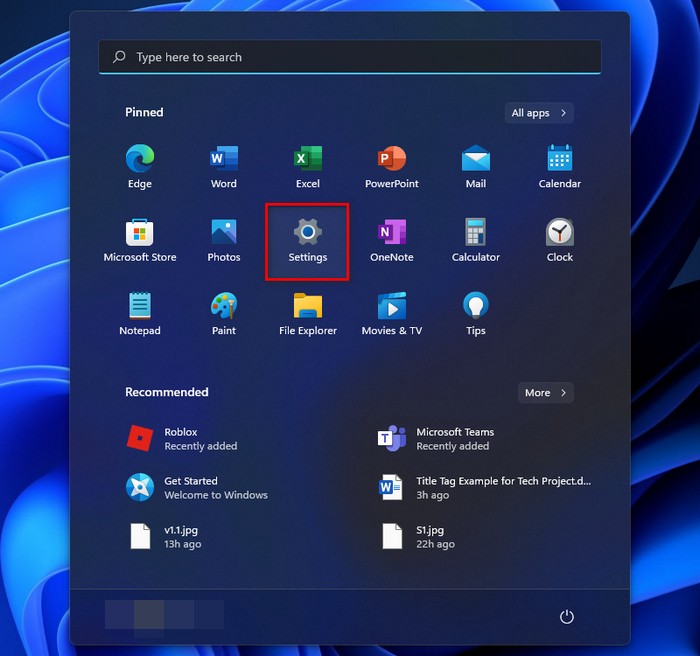
- Navigate to System from the left pane and click on it. (2)
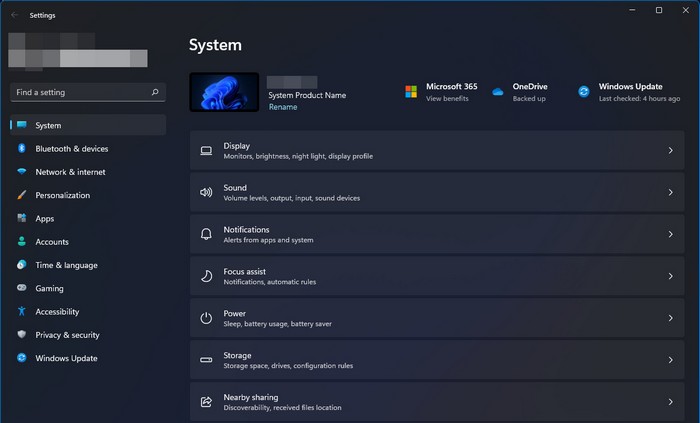
- Click on Recovery. (3)
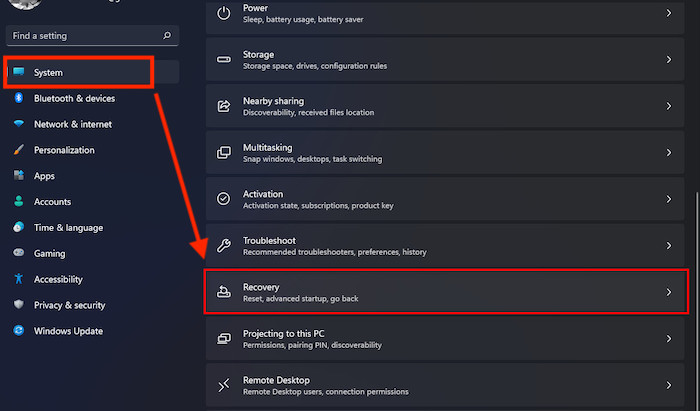
- Click on the Go back button within the Previous version of Windows section.
- Select a reason for which you are going back to Windows 10 and click on the Next button.
- Click on No thanks if you are prompted to install an update.
- Click on the Next button.
- Sign in to your Microsft account if you are prompted to do so.
- Click on the Go back to Windows 11 button to start uninstalling Windows 11 from your system.
If you did not see the Get Back button, it is because the time period of going back to Windows 10 has been over.
Go through the other methods in this post if this procedure did not help you.
Follow our guide to Fix When Windows 11 Won’t Install.
2. Uninstall Windows 11 Using Windows 10 Backup
You can easily uninstall Windows 11 from your system to go back to Windows 10 if you have backed up the Windows 10 files somewhere in your system.
You had to make a system image in order to back up the files from your Windows 10 operating system. You need to use a repair disc to boot your system into the Windows Recovery Environment to restore the previous version of Windows that was previously on your system.
It is very easy to Uninstall Windows 11 using the Windows 10 backup files, so there is no reason for you to be nervous.
The steps are straightforward so you will not have a hard time. Keep calm and go through the simple steps given below.
Here are the steps to use Windows 10 backup files to uninstall Windows 11:
- Connect the storage device that contains the Windows 10 backup image. If the backup image is in your hard disk drive or SSD, skip this step and follow the next one.
- Reboot your pc using the repair disc.
- Click on Next in the Setup screen.
- Select Repair your computer.
- Enter Troubleshoot and click on Advanced options.
- Click on System Restore.
- Sign in with your Microsoft account or user account.
- Select the backup and click on Next.
- Follow the on-screen prompts and you will be good to go.
If you have followed the steps properly, Windows 11 must have been uninstalled and your system must have Windows 10 installed on it.
Remember that you might need to reinstall some apps that were available on your Windows 11 Operating System.
3. Uninstall Windows 11 by Clean Installing Windows 10
A clean install means deleting everything that was previously there and installing everything again from scratch.
Following this method means you will be deleting everything that was present on your Windows 11 Operating System and reinstalling them again for Windows 10. If you have any important files, make sure to bak them up before following this procedure.
This process is very easy to follow, so do not panic, keep calm and go through the simple steps given below.
Here are the steps to uninstall Windows 11 by clean installing Windows 10:
- Go to the official website and download the installation files for Windows 10.
- Open the Win10 ISO file and open the Setup file within it.
- Select the language, time and keyboard.
- Click on Next.
- Navigate to Install now and click on it
- Select the hard drive.
- Accept the Microsoft Software License Terms.
- Click on Custom: Install Windows only(Advanced).
- Wait for the installation process to finish.
If you have followed the steps properly, Windows 11 must have been uninstalled and your system must have Windows 10 installed on it.
Check out our separate post on 5 Effective Ways To Uninstall IE11 Windows 10.
How to Upgrade to Windows 11 from Windows 10
You can follow the simple procedures below to upgrade to Windows 11 from Windows 10 easily. The procedures are straightforward, so you have no reason to worry or doubt yourself. Keep your cool and go through the methods given below.
Here are the methods to upgrade to Windows 11 from Windows 10:
1. Use Windows 11 Download assistant
The Windows 11 download assistant can be downloaded from the official Microsoft website. Go to your internet browser and enter the final Microsoft website to download the Download Assistant and use it to install Windows 11.
This process is pretty straightforward, so go through the simple steps given below.
Here are the steps to use the installation Assistant to upgrade to Windows 11:
- Go to the official Microsoft website.
- Download the Installation Assistant.
- Run the Installation Assistant.
- Follow the on-screen prompts.
If you have followed the steps properly, Windows 11 must be installed on your System.
2. Use Windows 11 Media Creation Tool
You can also use the Media creation tool that can be found on the official Microsoft website to install Windows 11 on your System.
This method is relatively simple, so go through the straightforward steps below.
Here are the steps to use the Media Creation Tool to upgrade to Windows 11:
- Go to the official Microsoft website.
- Download the Installation Assistant.
- Run the Installation Assistant.
- Select ISO file.
- Run the ISO file from your HDD/SSD or another storage device.
- Follow the on-screen prompts.
If you have followed the steps properly, Windows 11 must be installed on your System.
Quickly, check out our latest fix for Bluetooth Toggle Missing On Windows 11.
Conclusion
I hope you were able to go back to Windows 10. I do not know why you went back to Windows 10, but I hope they fix the issues for which you did not keep using Windows 11 on your system.
I hope you never face problems in using Windows 10 or 11. Both are great operating systems, so use the one that you are more comfortable with.
I wish you luck in whatever you do n the future. Take care and stay safe!

